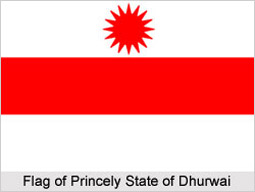 The Princely State of Dhurwai was one of the significant princely states in India under the indirect rule of the British East India Company. The state was administered and supervised by the native ruler, also addressed as Indian Prince by the British authorities. Dhurwai State was spread over a total area of 15 sq miles the population of the princely state was 2,423 in the year 1941, according to the Census of India. The territory of Dhurwai was located in the Bundelkhand region, towards the east of Jhansi state. It comprised of 6 villages in 1941. The princely state of Dhurwai was entirely bounded by the British United Provinces of Agra and Oudh, excluding the eastern region, where it was bordered by the territory of Tori Fatehpur and by the state of Bijna in the west, both of them similarly infinitesimal. The Princely State of Dhurwai was included as a part of the Bundelkhand Agency, which was a sub division of the Central India Agency.
The Princely State of Dhurwai was one of the significant princely states in India under the indirect rule of the British East India Company. The state was administered and supervised by the native ruler, also addressed as Indian Prince by the British authorities. Dhurwai State was spread over a total area of 15 sq miles the population of the princely state was 2,423 in the year 1941, according to the Census of India. The territory of Dhurwai was located in the Bundelkhand region, towards the east of Jhansi state. It comprised of 6 villages in 1941. The princely state of Dhurwai was entirely bounded by the British United Provinces of Agra and Oudh, excluding the eastern region, where it was bordered by the territory of Tori Fatehpur and by the state of Bijna in the west, both of them similarly infinitesimal. The Princely State of Dhurwai was included as a part of the Bundelkhand Agency, which was a sub division of the Central India Agency.
History of Princely State of Dhurwai
The Princely State of Dhurwai was amongst the Hasht Bhaiya jagirs, which were initially a part of the princely state of Orchha. The Bundela Rajputs, who were descendants of the 4th son of Diwan Rai Singh of Baragaon, named Man Singh, were the ruling family of the state. The ruling family was later segregated into 3 distinct groups, for the purposes of succession. Dhurwai state was a non-salute state of India. The native ruler of the state, who held the title of Diwan or Jagirdar, exercised administrative authority over the territory and supervised the internal affairs of the region. In the year 1862, the obligation of the native state to pay annual revenue or nazarana to its overlord on each succession was abolished by the British Government of India as reward for support of the native ruler during the Sepoy Mutiny of 1857.
The Diwan of Dhurwai State was one of the original constituent members of the Chamber of Princes, which was a number of smaller states indirectly represented by 12 princes who were elected periodically.
The Princely State of Dhurwai was acceded to the newly formed Union of India after the Indian Independence on 15th August 1947.



















